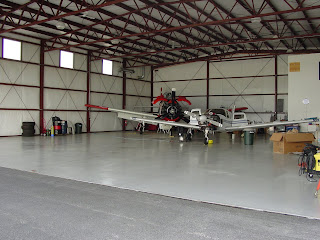An aircraft hangar is an interesting place. Not only does it house airplanes, but it can also serve as the maintenance facility for an aviation business. On the one hand, a hangar is static - quietly providing shelter to important and very valuable assets. Yet, when used as a repair facility, a hangar is a vibrant location where airplanes come alive. It is fun to spend time in hangars and over the years, I have learned quite a bit from the hangars themselves as well as the mechanics that I've observed. Here are a few leadership lessons from my travels around these hangars:
- Flexibility is valuable. Hangars that serve multiple purposes are worth more than the single-purpose variety. This simple observation is immediately applicable to leadership. When leading others, an ability to connect with people at all levels is a highly coveted skill. Most leaders are comfortable when managing or directing those who are similar to themselves in style, education or technical skills. Far fewer leaders possess the talent to equally motivate and inspire a team of individuals with vastly different backgrounds or experience. This skill can be developed by seizing opportunities to work with a broad range of people. Volunteer organizations often attract a diverse range of individuals and are a great way to build your personal network.
- Everything - and everyone - has a limit. There is a term in aviation called "stacking the hangar." It applies to the art of carefully maneuvering aircraft of various shapes and sizes into a storage hangar, maximizing space to fit as many aircraft as can safely be accommodated. Nevertheless, there is a limit. Trying to squeeze that very last plane into a corner of a full hangar runs the risk of expensive damage and downtime. The same is true for humans. Even top-level performers have a limited amount of mental energy or physical capacity. While it may appear that your superstars can tackle an extra task, offer opportunities to reprioritize rather than layering on more. Pushing a group too hard or constantly holding team members to unrealistic deadlines when plates are already full can quickly result in disengagement, job dissatisfaction and potentially even physical illness.
- Put down the screwdriver and go to lunch. Mechanical work can be frustrating. Repairs that seem easy can become complex and challenging when a fastener breaks, holes don't quite line up or an unseen crack appears on the inside of a casing. Generally, when things don't go quite right in the mechanical world, problems multiply. This causes a seemingly simple task to become increasingly demanding. It is precisely at this moment that the best mechanics know to put down the screwdriver and go to lunch. Many times, returning to the repair task with a clear head and relaxed psyche will result in smooth and quick progress. In the leadership world, when chaos reigns and matters seem to be spinning out of control, leaders are well served to insert a pause, relative to the scope of the situation. Small challenges might be soothed with a quick coffee break, while larger ones may call for a hiatus of a day or longer. Although it may seem counterintuitive to deflect time away from a project that is souring, fresh perspectives and re-energized brains often reach breakthrough far more effectively.
- Judge the space needed and give a bit more. I once encountered a young man who had just attempted to fit an airplane with a 10-foot tail under a door opened to about 9.8 feet. The sound of metal scraping on metal was clear indication that providing just a little more space would have been nice. When asked why he did not open the door a bit more (since it was possible to open the door to a height of 12 feet,) the young man indicated that he simply thought it would fit. This situation holds a wonderful leadership lesson with a parallel to work-life balance. Do all that you can in this area for your employees and then, give just a little more. True work-life balance is hard to achieve in the 24/7, fully wired world in which we live. Providing employees a little extra space by carefully respecting family time or giving an unexpected block of time off is an inexpensive form of recognition that pays enormous dividends in engagement and productivity.
 |
| Hangars Can Offer Valuable Lessons |
The next time you pass by an aircraft hangar, think about the activities that may be occurring inside. It's likely that someone is just about ready to put down the screwdriver and go to lunch, soon to return with a fresh perspective, renewed energy and important focus to solve the most challenging problems.
